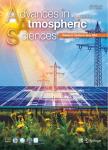Validation of Sea Level Data in the East Asian Marginal Seas: Comparison between TOPEX/POSEIDON Altimeter and In-Situ Tide Gauges
Validation of Sea Level Data in the East Asian Marginal Seas: Comparison between TOPEX/POSEIDON Altimeter and In-Situ Tide Gauges作者机构:Meteorological Research Institute/Korea Meteorological AdministrationSeoulKoreaResearch Institute of OceanographySeoul National UniversitySeoulKoreaDepartment of Earth SciencesSejing UniversitySeoulKoreaLaboratoire d'Oceanographie PhysiqueMuseum National d'Histoire NaturelleParisDepartment of Earth SciencesSejong UniversitySeoulKorea
出 版 物:《Advances in Atmospheric Sciences》 (大气科学进展(英文版))
年 卷 期:2003年第20卷第4期
页 面:650-660页
核心收录:
学科分类:07[理学] 0707[理学-海洋科学] 0706[理学-大气科学] 0816[工学-测绘科学与技术] 0825[工学-航空宇航科学与技术]
主 题:sea level TOPEX/POSEIDON altimeter tide gauge
摘 要:In an effort to assess the reliability of satellite altimeter systems, the authors conduct a comparative analysis of sea level data that were collected from the TOPEX/POSEIDON (T/P) altimeter and 10 tide gauges (TG) near the satellite passing ground tracks. The analysis is made using datasets collected from marginal sea regions surrounding the Korean Peninsula at T/P cycles of 2 to 230, which correspond to October 1992 to December 1998. Proper treatment of tidal errors is a very critical step in data processing because the study area has very strong tide. When the T/P data are processed, the procedures of Park and Gamberoni (1995) are adapted to reduce errors associated with the tide. When the T/P data are processed in this way, the alias periods of M2, S2, and K1 constituents are found to be 62.1, 58.7, and 173 days repectively. The compatibility of the T/P and TG datasets are examined at various filtering periods. The results indicate that the low-frequency signals of the T/P data can be interpreted more safely with longer filtering periods (such as up to the maximum selected value of 200 days). When RMS errors for the 200-day low-pass filter period are compared with all 10 tidal stations, the values span the range of 2.8 to 6.7 cm. The results of a correlation analysis for this filtering period also show a strong agreement between the T/P and TG datasets across all stations investigated (e.g.,p- values consistently less than 0.001). Hence according to the analysis, the conclusion is made that the analysis of surface sea level using satellite altimeter data can be made safely with reasonably extended filtering periods such as 200 days.



